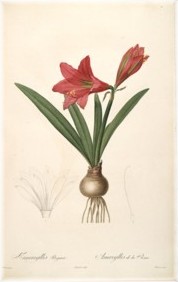Amorous Amaryllis
By Audrey Stallsmith

You are ice and fire,
The touch of you burns my hands like snow.
You are cold and flame.
You are the crimson of amaryllis. . .
"Opal"--Amy Lowell
The amaryllis proves almost as popular as the poinsettia over the holiday season. With snow on the ground and summer’s garden lilies only a distant memory, this easy and flashy look-alike lifts spirits and decorates Christmas parties.
Once known as lilio-narcissus, its pre-potted bulbs are often considered the perfect gift for elderly aunts or shut-ins! And its blooms fortunately lack the lily’s strong scent, which can be overpowering in a house insulated against the winter cold.
Technically, though, the amaryllis isn’t really an amaryllis. That name is reserved for the Belladonna Lily and its relatives, also known as Naked Ladies, which originated in South Africa. They bloom in the garden during late summer on leafless stems—hence the latter nickname!
In mythology Amaryllis was a lovelorn shepherdess who pierced her own heart to produce a new flower for the hard-hearted—and probably ungrateful!—shepherd she loved. In literature she has come to stand, however, for any rural sweetheart.
The holiday-flowering bulb we know by her name is actually a hippeastrum. That name translates to "horseman’s star” or “knight’s star,” while amaryllis, appropriately enough, derived from the Greek amaryssein ("to sparkle.") Nobody knows how the knight came into it, though some speculate that the plant's partially opened buds might be thought to resemble a horse's head.
This "Christmas star" originated, not "in the east," but in the Andes of South America. One of the most cold-tolerant types—a red and white variety known as St. Joseph’s Lily or hippeastrum johnsonii—is supposed to be hardy to Zone 6 and is believed to be a cross between hippeastrum vittanum and the reginae that is pictured here. Most hippeastrums are, however, only hardy to about Zone 8. So the rest of us have to enjoy them indoors.
We won’t feel bad about that, however, because in the house is where we need them at the bleakest time of year! If you want to save yours for next winter, you’ll need to keep it growing in good light after it blooms, and for the rest of the winter, spring, and summer. The plant must produce at least four large leaves to have any hope of blooming again. (It helps to set the pot outdoors in a sunny spot during the warmer months.)
In the fall, bring your amaryllis indoors, place it in a cool, dim area, and stop watering it for six to eight weeks. During that time, the leaves should die back. The bulb will often begin sending up a bud stalk on its own after that time. If not, set the pot in a bright window and water the bulb only sparingly until it begins to show signs of life.
Older amaryllis plants will often produce smaller bulbs known as offsets, which can be separated from their parent. But it will probably take them at least a couple years before they get large enough to bloom.
There are also a few types, like my butterfly amaryllis (papilio), which don’t require a dormant period to produce flowers. Perhaps due to its association with the unfortunate shepherdess, this plant has stood for both "pride" and "timidity," as well as "splendid beauty" in the Language of Flowers. As Denise Levertov wrote in her poem “The Metier of Blossoming:”
Fully occupied with growing--that's
the amaryllis...
If humans could be
that intensely whole, undistracted, unhurried,
swift from sheer
unswerving impetus! If we could blossom
out of ourselves, giving
nothing imperfect, withholding nothing!
Plant plate is by P. J. Redoute from Les Liliacees, courtesy of the Missouri Botanical Garden Library.








